Abacus to Predict Groundwater Recharge at Non-Instrumented Hydrographic Basins
Abstract
1. Introduction
2. Materials and Methods
2.1. Mapping the Spatial Distribution of the Recharge Rates
2.1.1. Numerical Modelling of the Saturated Zone
2.1.2. Distributed Hydrological Modelling of the Vadose Zone
2.1.3. Spatialization of Point Estimations Calculated Using Water Table Level Elevation
2.2. Generation of Recharge Codes and Average Recharge Values for Possible Combinations between Soil, Land Use/Cover, and Slope
- soil class: 1 = cambisol; 2 = red-yellow ferrasol; 3 = gleysol; 4 = red ferrasol; 5 = plinthosol;
- land use/cover: 1 = riparian forest; 2 = forest/reforestation; 3 = perennial tree culture; 4 = cerrado fields; 5 = shrub cerrado; 6 = open cerrado grassland; 7 = pasture; 8 = baresoil;
- slope: 1 = slope between 0 and 5%; 2 = slope between 5 and 10%; 3 = slope between 10 and 15%; 4 = slope over 15%;
2.3. Verification of Average Abacus Recharge Rates
3. Results and Discussion
4. Conclusions
- the potential recharge varies according to the soil class. However, in the same type of soil, land use/cover and slope can cause large variations in recharge rates;
- for combinations between Cambisols and high slopes, the differences between simulated and regionalized potential recharge rates are high, indicating, in this case, caution on the adoption of values suggested by the abacus. As the calibration and verification of hydrological models are proceeds at the basin or sub-basin level, it is necessary to perform site specific studies to confirm the recharge rate actual order of magnitude;
- for soils with more homogeneous porous matrix, such as Ferrasol, the difference between simulated and regionalized rates was smaller, indicating greater reliability on the values suggested by the abacus for such situations;
- the regionalized values of potential recharge suggested by the abacus for combinations with Ferrasols were considered consistent, with order of magnitude confirmed by Cambraia-Neto and Rodrigues [8] and Araujo [42]. Thus, for these combinations, the suggested values can be transferred to other areas or basins in the Cerrado biome with similar characteristics. Similar values estimated by Souza et al. [2] for this type of soil, but with different climate and biome, suggest that the abacus values for Ferrasols may also be valid for other Brazilian biomes;
- the divergences between simulated and regionalized estimations observed in areas with the same soil type, land cover and slope are a result of the conceptual and mathematical formulations specific in the models used, mostly regarding the calculation of actual evapotranspiration, which confirms Araujo [42] and Arroio Junior [54];
- the average effective rates of recharge—NM and WTE—suggested by the abacus were considered consistent, with values in the same order of magnitude as the reference values in the literature. However, the regionalization of these recharge rates would only be possible if the study basin has at least the three predominant classes of soil in the Capão Comprido basin—conditions in which the abacus was generated;
- new studies could produce a more robust abacus. In this sense, it is recommended to focus on the hydro-physical characterization of the soil types, which would enhance the range and reliability of future regionalization of proposed values;
- for non-instrumented basins with physical characteristics similar to the study area, also used to validate the results, the abacus could be an useful tool for surface and groundwater resources integrated management, since the recharge rates can be obtained in an easier way, just by knowing annual average rainfall, land use, soil type, and slope of the new study area, which are data relatively easy to obtain.
Author Contributions
Funding
Acknowledgments
Conflicts of Interest
References
- Bortolin, T.A.; Reginato, P.A.R.; Presotto, M.A.; Schneider, V.E. Estimativas de recarga aquífera com uso de filtros digitais em sub-bacias hidrográficas do Sistema Aquífero Serra Geral no estado do Rio Grande do Sul. Sci. Cum Ind. 2018, 6, 21–30. [Google Scholar] [CrossRef]
- Souza, E.; Pontes, L.M.; Fernandes Filho, E.I.; Schaefer, C.E.G.R.; Santos, E.E. Spatial and temporal potential groundwater recharge: The case of the doce river basin, Brazil. Rev. Bras. Cienc. Solo 2019, 43, 1–27. [Google Scholar] [CrossRef]
- Rahman, A.T.M.S.; Hosono, T.; Mazumnder, Q.H.; Jahan, C.S. Sustainable Groundwater Management in Context of Climate Change in Northwest Bangladesh. In Achievements and Challenges of Integrated River Basin Management; IntechOpen: London, UK, 2018; pp. 101–120. [Google Scholar]
- Alfranca, O. Groundwater Management Competitive Solutions: The Relevance of the Gisser-Sanchez Model. In Groundwater—Resource Characterisation and Management Aspects; IntechOpen: London, UK, 2019; pp. 1–13. [Google Scholar]
- Megdal, S.B. Invisible water: The importance of good groundwater governance and management. Npj Clean Water 2018, 1, 15. [Google Scholar] [CrossRef]
- Ministério do Meio Ambiente—MMA. Plano Nacional de Recursos Hídricos: Panorama e Estado dos Recursos Hídricos do Brasil; Ministério do Meio Ambiente, Secretaria de Recursos Hídricos: Brasília, Brazil, 2006; ISBN 8577380092.
- Gonçalves, V.F.M.; Manzione, R.L. Estimativa da recarga das águas subterrâneas no Sistema Aquífero Bauru (SAB). Geo UERJ 2019, 35, 2–19. [Google Scholar] [CrossRef]
- Cambraia-Neto, A.J.; Rodrigues, L.N. Evaluation of groundwater recharge estimation methods in a watershed in the Brazilian Savannah. Environ. Earth Sci. 2020, 79, 140. [Google Scholar] [CrossRef]
- Carrera-Hernández, J.J.; Smerdon, B.D.; Mendoza, C.A. Estimating groundwater recharge through unsaturated flow modelling: Sensitivity to boundary conditions and vertical discretization. J. Hydrol. 2012, 452, 90–101. [Google Scholar] [CrossRef]
- Mohan, C.; Western, A.W.; Wei, Y.; Saft, M. Predicting groundwater recharge for varying land cover and climate conditions—A global meta-study. Hydrol. Earth Syst. Sci. 2018, 22, 2689–2703. [Google Scholar] [CrossRef]
- Kubicz, J.; Kajewski, I.; Kajewska-Szkudlarek, J.; Dąbek, P.B. Groundwater recharge assessment in dry years. Environ. Earth Sci. 2019, 78, 555. [Google Scholar] [CrossRef]
- Scanlon, B.R.; Healy, R.W.; Cook, P.G. Choosing appropriate techniques for quantifying groundwater recharge. Hydrogeol. J. 2002, 10, 18–39. [Google Scholar] [CrossRef]
- Singh, A.; Panda, S.N.; Uzokwe, V.N.E.; Krause, P. An assessment of groundwater recharge estimation techniques for sustainable resource management. Groundw. Sustain. Dev. 2019, 9. [Google Scholar] [CrossRef]
- Mattos, T.S.; de Oliveira, P.T.S.; Lucas, M.C.; Wendland, E. Groundwater recharge decrease replacing pasture by Eucalyptus plantation. Water 2019, 11, 1213. [Google Scholar] [CrossRef]
- Walker, D.; Parkin, G.; Schmitter, P.; Gowing, J.; Tilahun, S.A.; Haile, A.T.; Yimam, A.Y. Insights from a multi-method recharge estimation comparison study. Groundwater 2019, 57, 245–258. [Google Scholar] [CrossRef]
- Carvalho, F.; Scopel, I. Escoamento superficial e recarga d’água subterrânea em diferentes usos do solo na microbacia do córrego do queixada. Rev. Caminhos Geogr. 2018, 19, 133–145. [Google Scholar] [CrossRef]
- Joshi, S.K.; Rai, S.P.; Sinha, R.; Gupta, S.; Densmore, A.L.; Rawat, Y.S.; Shekhar, S. Tracing groundwater recharge sources in the northwestern Indian alluvial aquifer using water isotopes (δ18O, δ2H and 3H). J. Hydrol. 2018, 559, 835–847. [Google Scholar] [CrossRef]
- Richards, L.A.; Magnone, D.; Boyce, A.J.; Casanueva-Marenco, M.J.; van Dongen, B.E.; Ballentine, C.J.; Polya, D.A. Delineating sources of groundwater recharge in an arsenic-affected Holocene aquifer in Cambodia using stable isotope-based mixing models. J. Hydrol. 2018, 557, 321–334. [Google Scholar] [CrossRef]
- Li, Z.; Jasechko, S.; Si, B. Uncertainties in tritium mass balance models for groundwater recharge estimation. J. Hydrol. 2019, 571, 150–158. [Google Scholar] [CrossRef]
- Parlov, J.; Kovač, Z.; Nakić, Z.; Barešić, J. Using water stable isotopes for identifying groundwater recharge sources of the unconfined alluvial Zagreb aquifer (Croatia). Water 2019, 11, 2177. [Google Scholar] [CrossRef]
- Ahmed, I.M.; Jalludin, M.; Razack, M. Hydrochemical and isotopic assessment of groundwater in the Goda mountains range system. Republic of Djibouti (horn of Africa). Water 2020, 12, 2004. [Google Scholar] [CrossRef]
- Tenenwurcel, M.A.; de Moura, M.S.; da Costa, A.M.; Mota, P.K.; Viana, J.H.M.; Fernandes, L.F.S.; Pacheco, F.A.L. An improved model for the evaluation of groundwater recharge based on the concept of conservative use potential: A study in the river Pandeiros Watershed, Minas Gerais, Brazil. Water 2020, 12, 1001. [Google Scholar] [CrossRef]
- Lacombe, G.; Douangsavanh, S.; Vongphachanh, S.; Pavelic, P. Regional assessment of groundwater recharge in the lower mekong basin. Hydrology 2017, 4, 60. [Google Scholar] [CrossRef]
- Yang, W.; Xiao, C.; Liang, X. Extraction method of baseflow recession segments based on second-order derivative of streamflow and comparison with four conventional methods. Water 2020, 12, 1953. [Google Scholar] [CrossRef]
- Rukundo, E.; Doğan, A. Dominant influencing factors of groundwater recharge spatial patterns in Ergene river catchment, Turkey. Water 2019, 11, 653. [Google Scholar] [CrossRef]
- Neukum, C.; Azzam, R. Impact of climate change on groundwater recharge in a small catchment in the Black Forest, Germany. Hydrogeol. J. 2012, 20, 547–560. [Google Scholar] [CrossRef]
- Wiebe, A.J.; Rudolph, D.L. On the sensitivity of modelled groundwater recharge estimates to rain gauge network scale. J. Hydrol. 2020, 585, 124741. [Google Scholar] [CrossRef]
- Hund, S.V.; Allen, D.M.; Morillas, L.; Johnson, M.S. Groundwater recharge indicator as tool for decision makers to increase socio-hydrological resilience to seasonal drought. J. Hydrol. 2018, 563, 1119–1134. [Google Scholar] [CrossRef]
- Ashaolu, E.D.; Olorunfemi, J.F.; PaulIfabiy, I.; Abdollahi, K.; Batelaan, O. Spatial and temporal recharge estimation of the basement complex in Nigeria, West Africa. J. Hydrol. Reg. Stud. 2020, 27, 100658. [Google Scholar] [CrossRef]
- Gonçalves, R.D.; Teramoto, E.H.; Engelbrecht, B.Z.; Alfaro Soto, M.A.; Chang, H.K.; van Genuchten, M.T. Quasi-Saturated Layer: Implications for Estimating Recharge and Groundwater Modeling. Groundwater 2019, 58, 432–440. [Google Scholar] [CrossRef]
- Ouyang, Y.; Jin, W.; Grace, J.M.; Obalum, S.E.; Zipperer, W.C.; Huang, X. Estimating impact of forest land on groundwater recharge in a humid subtropical watershed of the Lower Mississippi River Alluvial Valley. J. Hydrol. Reg. Stud. 2019, 26, 100631. [Google Scholar] [CrossRef]
- Petronici, F.; Pujades, E.; Jurado, A.; Marcaccio, M.; Borgatti, L. Numerical modelling of the Mulino Delle Vene Aquifer (Northern Italy) as a tool for predicting the hydrogeological system behavior under different recharge conditions. Water 2019, 11, 2505. [Google Scholar] [CrossRef]
- Bizhanimanzar, M.; Leconte, R.; Nuth, M. Catchment-Scale Integrated Surface Water-Groundwater Hydrologic Modelling Using. Water 2020, 12, 363. [Google Scholar] [CrossRef]
- Flinchum, B.; Banks, E.; Hatch, M.; Batelaan, O.; Peeters, L.; Pasquet, S. Identifying recharge under subtle ephemeral features in flat-lying semi-arid region using a combined geophysical approach. Hydrol. Earth Syst. Sci. Discuss. 2020, 24, 4353–4368. [Google Scholar] [CrossRef]
- Ali, M.; Mubarak, S. Approaches and Methods of Quantifying Natural Groundwater Recharge—A Review. Asian J. Environ. Ecol. 2017, 5, 1–27. [Google Scholar] [CrossRef]
- Chang, C.F.; Rubin, Y. Regionalization with hierarchical hydrologic similarity and ex situ data in the context of groundwater recharge estimation at ungauged watersheds. Hydrol. Earth Syst. Sci. 2019, 23, 2417–2438. [Google Scholar] [CrossRef]
- Monte-Mor, R.C.A.; Palmier, L.R.; Pinto, E.J.A.; Lima, J.E.S. Estabilidade temporal da distribuição espacial da umidade do solo em uma bacia intermitente no semiárido de Minas Gerais. Rev. Bras. Recur. Hidr. 2012, 17, 101–113. [Google Scholar] [CrossRef]
- Lima, J.E.F.W.; Montenegro, S.M.G.L.; de Montenegro, A.A.A.; Koide, S. Comparative hydrology: Relationships among physical characteristics, hydrological behavior, and results of the SWAT model in different regions of Brazil. Rev. Bras. Geogr. Física 2014, 7, 1187–1195. [Google Scholar]
- Creed, I.F.; Spargo, A.T.; Jones, J.A.; Buttle, J.M.; Adams, M.B.; Beall, F.D.; Booth, E.G.; Campbell, J.L.; Clow, D.; Elder, K.; et al. Changing forest water yields in response to climate warming: Results from long-term experimental watershed sites across North America. Glob. Chang. Biol. 2014, 20, 3191–3208. [Google Scholar] [CrossRef]
- Ibrahim, B.; Wisser, D.; Barry, B.; Fowe, T.; Aduna, A. Hydrological predictions for small ungauged watersheds in the Sudanian zone of the Volta basin in West Africa. J. Hydrol. Reg. Stud. 2015, 4, 386–397. [Google Scholar] [CrossRef]
- Santos, R.M.; Koide, S. Avaliação da recarga de águas subterrâneas em ambiente de cerrado com base em modelagem numérica do fluxo em meio poroso saturado. Rev. Bras. Recur. Hidr. 2016, 21, 451–465. [Google Scholar] [CrossRef]
- Araujo, D.L. Avaliação dos Impactos da Explotação de Águas Subterrâneas na Bacia do Ribeirão Rodeador por Meio de Simulação Integrada Entre os Modelos SWAT e MODFLOW. Master’s Thesis, Universidade de Brasília, Brasília, Brazil, 2018. Available online: https://repositorio.unb.br/handle/10482/34399 (accessed on 7 April 2020).
- Zomlot, Z.; Verbeiren, B.; Huysmans, M.; Batelaan, O. Spatial distribution of groundwater recharge and base flow: Assessment of controlling factors. J. Hydrol. Reg. Stud. 2015, 4, 349–368. [Google Scholar] [CrossRef]
- Ramires, T.; Manzione, R.L. Groundwater recharge estimation using water budget method for Bauru Aquifer system in a Cerrado environmental protection area. Appl. Res. Agrotechnol. 2019, 12, 25–36. [Google Scholar] [CrossRef]
- Silva, C.O.F. Modelagem Espacial da Recarga de Águas Subterrâneas Sob Diferentes Usos e Coberturas da Terra. Master’s Thesis, Universidade Estadual Paulista, São Paulo, Brazil, 2019. Available online: http://hdl.handle.net/11449/190710 (accessed on 19 April 2020).
- Charles, E.G.; Behroozi, C.; Schooley, J.; Hoffman, J.L. A Method for Evaluating Ground Water Recharge Areas in New Jersey; Trenton; 1993. Available online: https://www.nj.gov/dep/njgs/pricelst/gsreport/gsr32.pdf (accessed on 5 April 2020).
- Santos, R.M. Recarga de Águas Subterrâneas em Ambiente de Cerrado: Estudo com Base em Modelagem Numérica e Simulação Hidrológica em uma Bacia Experimental (Distrito Federal). Ph.D. Thesis, Universidade de Brasília, Brasília, Brazil, 2012. Available online: https://repositorio.unb.br/handle/10482/11253 (accessed on 9 April 2020).
- CPRM; Embrapa. Zoneamento Ecológico—Econômico da Região Integrada de Desenvolvimento do Distrito Federal e Entorno: Fase I; Ministério do Meio Ambiente: Rio de Janeiro, Brazil, 2003; Volume 1.
- Reatto, A.; Martins, É.D.S.; Cardoso, E.A.; Spera, S.T.; Carvalho, O.A., Jr.; De Silva, A.V.; Farias, M.F.R. Levantamento de Reconhecimento de Solos de Alta Intensidade do Alto Curso do Rio Descoberto; Distrito Federal, Brasília. 2003. Available online: http://ainfo.cnptia.embrapa.br/digital/bitstream/CPAC-2009/25006/1/bolpd_92.pdf (accessed on 11 April 2020).
- Liu, Y.B.; De Smedt, F. WetSpa Extension, a GIS-Based Hydrologic Model for Flood Prediction and Watershed Management Documentation and User Manual; Brussel, Belgium. 2004. Available online: https://www.vub.be/WetSpa/downloads/WetSpa_manual.pdf (accessed on 3 April 2020).
- Healy, R.W.; Cook, P.G. Using groundwater levels to estimate recharge. Hydrogeol. J. 2002, 10, 91–109. [Google Scholar] [CrossRef]
- Bailey, R.T. TUTORIAL SWAT-MODFLOW. Documentación para la Preparación del Acoplamiento SWAT-MODFLOW. 2015. Available online: https://swat.tamu.edu/media/115188/swat-modflow-tutorial-in-spanish.pdf (accessed on 24 April 2020).
- Brighenti, T.M. Modelagem hidrológica e avaliação de diferentes métodos de calibração para o modelo SWAT. Master’s Thesis, Universidade Federal de Santa Maria, São Paulo, Brazil, 2015. Available online: https://repositorio.ufsc.br/xmlui/handle/123456789/136347 (accessed on 17 April 2020).
- Arroio Junior, P.P. Aprimoramento das Rotinas E Parâmetros dos Processos Hidrológicos do Modelo Computacional Soil and Water Assessment Tool—Swat. Ph.D. Thesis, Universidade de São Paulo, São Paulo, Brazil, 2016. Available online: https://teses.usp.br/teses/disponiveis/18/18139/tde-25052017-084925/publico/TesePauloPonceArroioJunior.pdf (accessed on 29 April 2020).
- Yifru, B.A.; Chung, I.M.; Kim, M.G.; Chang, S.W. Assessment of groundwater recharge in agro-urban watersheds using integrated SWAT-MODFLOW model. Sustainbility 2020, 12, 6593. [Google Scholar] [CrossRef]
- Nossent, J.; Bauwens, W. Comparing SWAT and WetSpa on the River Grote Laak, Belgium. In Proceedings of the 4th International SWAT conference, Delft, The Netherlands, 2–6 July 2007. [Google Scholar]
- Polanco, E.I.; Fleifle, A.; Ludwig, R.; Disse, M. Improving SWAT model performance in the Upper Blue Nile River Basin using meteorological data integration and catchment scaling. Hydrol. Earth Syst. Sci. Discuss. 2017, 21, 4907–4926. [Google Scholar] [CrossRef]
- De Castro, K.B. Avaliação do Modelo SWAT na Simulaçaõ de Vazão em Bacia Agricola do Cerrado Intensamente Monitorada. Master’s Thesis, Universidade de Brasília, Brasília, Brazil, 2013. Available online: https://repositorio.unb.br/bitstream/10482/13863/1/2013_KassiaBatistaCastro.pdf (accessed on 25 April 2020).
- Gaspar, M.T.P. Sistema Aqüífero Urucuia: Caracterização Regional E Propostas De Gestão Sistema Aqüífero Urucuia. Ph.D. Thesis, Universidade de Brasília, Brasília, Brazil, 2006. Available online: https://repositorio.unb.br/handle/10482/6742 (accessed on 2 May 2020).
- Albuquerque, A.C.L.S.; Chaves, H.M.L. Estimativa de recarga da bacia do Rio das Fêmeas através de métodos manuais e automáticos Estimates of the recharge in the Femeas River basin by manual and automatic methods. Rev. Bras. Eng. Agrícola Ambient—Agriambi 2011, 15, 1123–1129. [Google Scholar] [CrossRef]
- Cunha, V.C.V. Avaliação da Interação Entre Águas Subterrâneas e Superficiais na Bacia do rio das Fêmeas, Sistema Aquífero Urucuia—Bahia, Centro de Desenvolvimento da Tecnologia Nuclear. Ph.D. Dissertations; 2017. Available online: http://rigeo.cprm.gov.br/xmlui/bitstream/handle/doc/18596/diss_viviane_cunha.pdf?sequence=1&isAllowed=y (accessed on 8 April 2020).
- Oliveira, P.T.S.; Wendland, E.; Nearing, M.A.; Scott, R.L.; Rosolem, R.; Da Rocha, H.R. The water balance components of undisturbed tropical woodlands in the Brazilian cerrado. Hydrol. Earth Syst. Sci. 2015, 19, 2899–2910. [Google Scholar] [CrossRef]
- Agência Nacional de Águas. Estudos hidrogeológicos e de vulnerabilidade do Sistema Aquífero Urucuia e proposição de modelo de gestão integrada compartilhada: Resumo executivo. 2017; 100p. Available online: https://metadados.ana.gov.br/geonetwork/srv/en/resources.get?id=499&fname=Resumo_Executivo_SAU.pdf&access=private (accessed on 16 April 2020).
- Agência Nacional de Águas. Estratégias de Manejo Sustentável dos Sistemas Aquíferos Urucuia e Areado e Conclusões. Relatório Final. Brasília; 2017; Volume 3. Available online: https://metadados.ana.gov.br/geonetwork/srv/en/resources.get?id=499&fname=Volume_3.pdf&access=private (accessed on 16 April 2020).
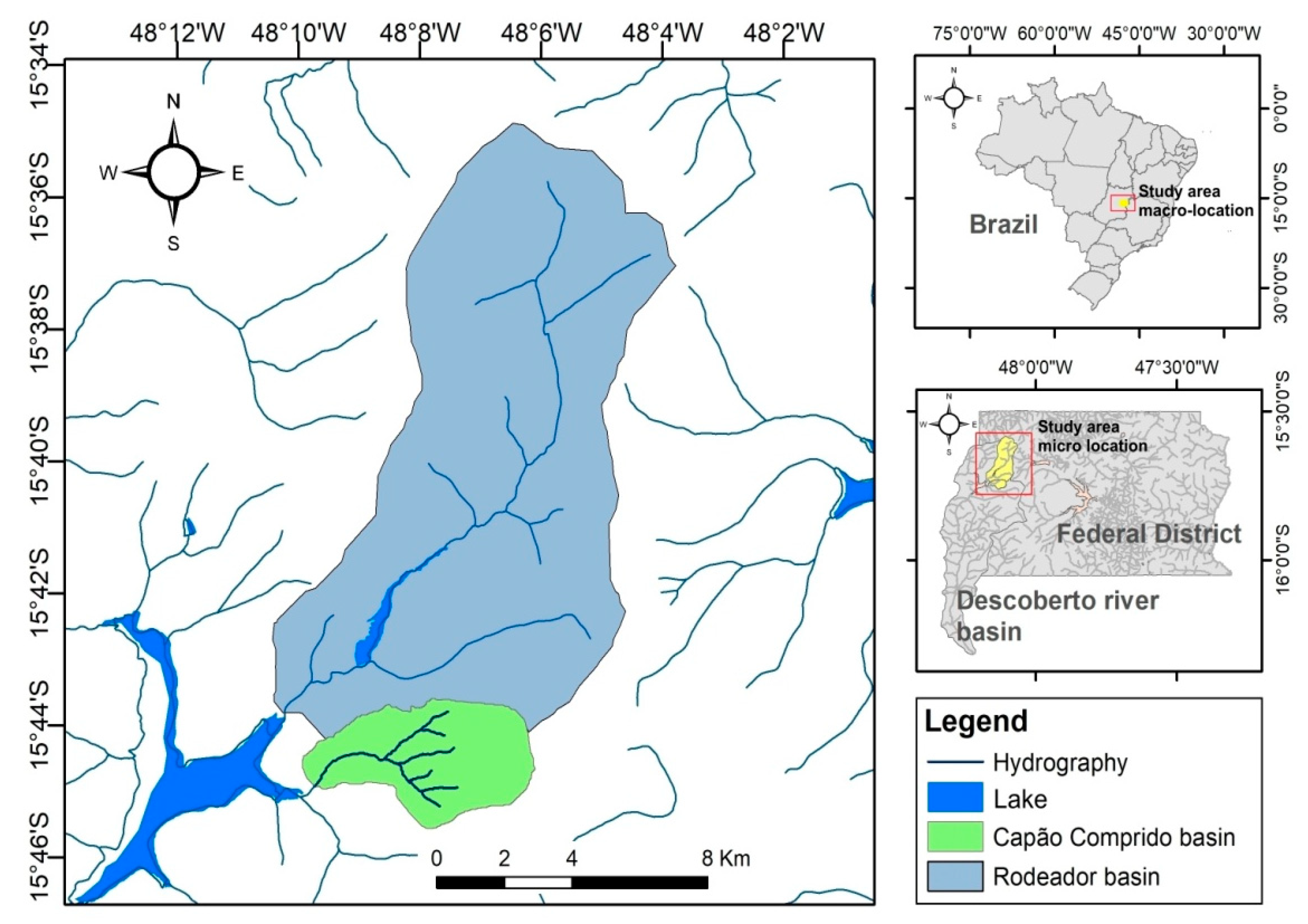
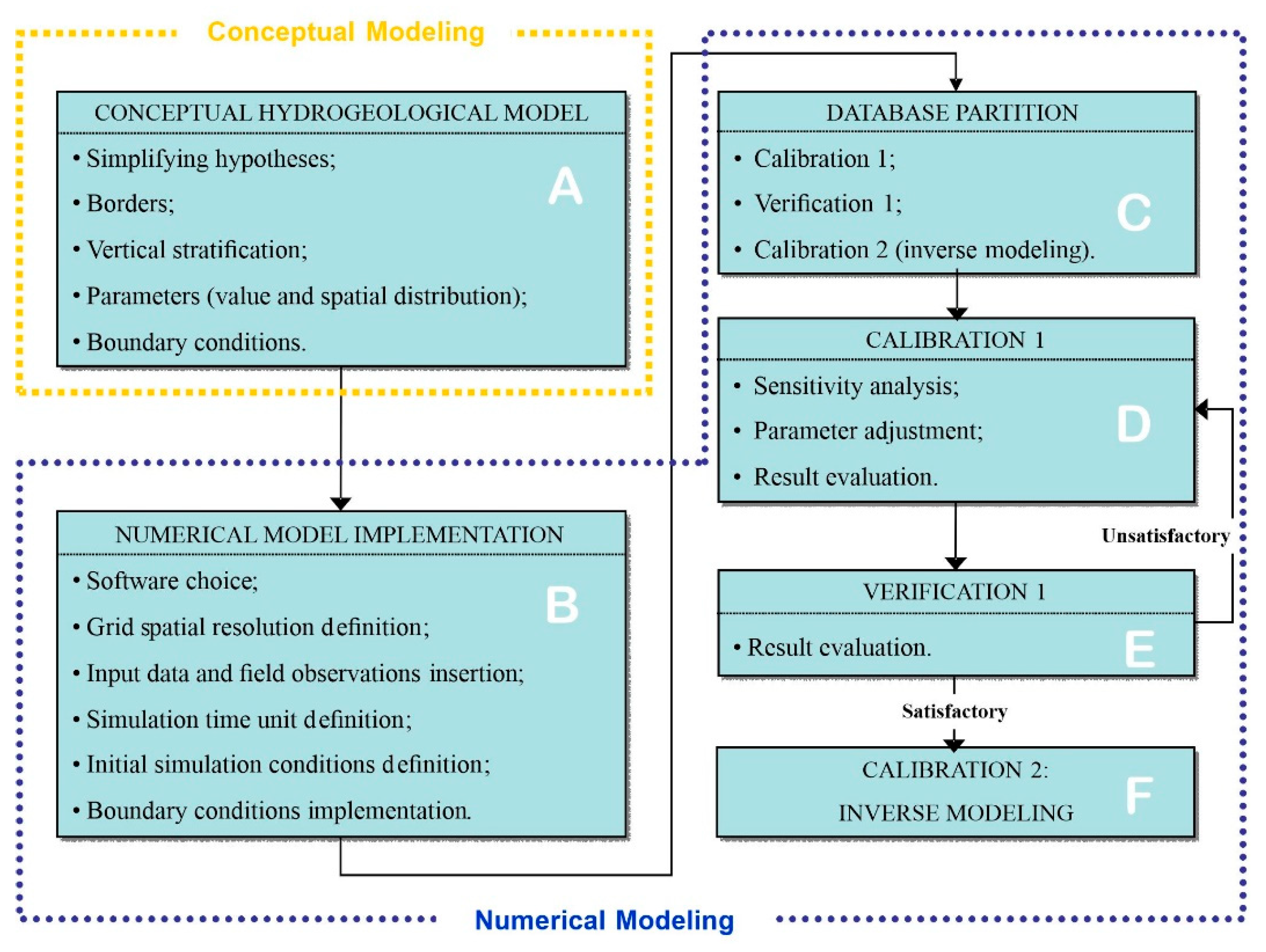
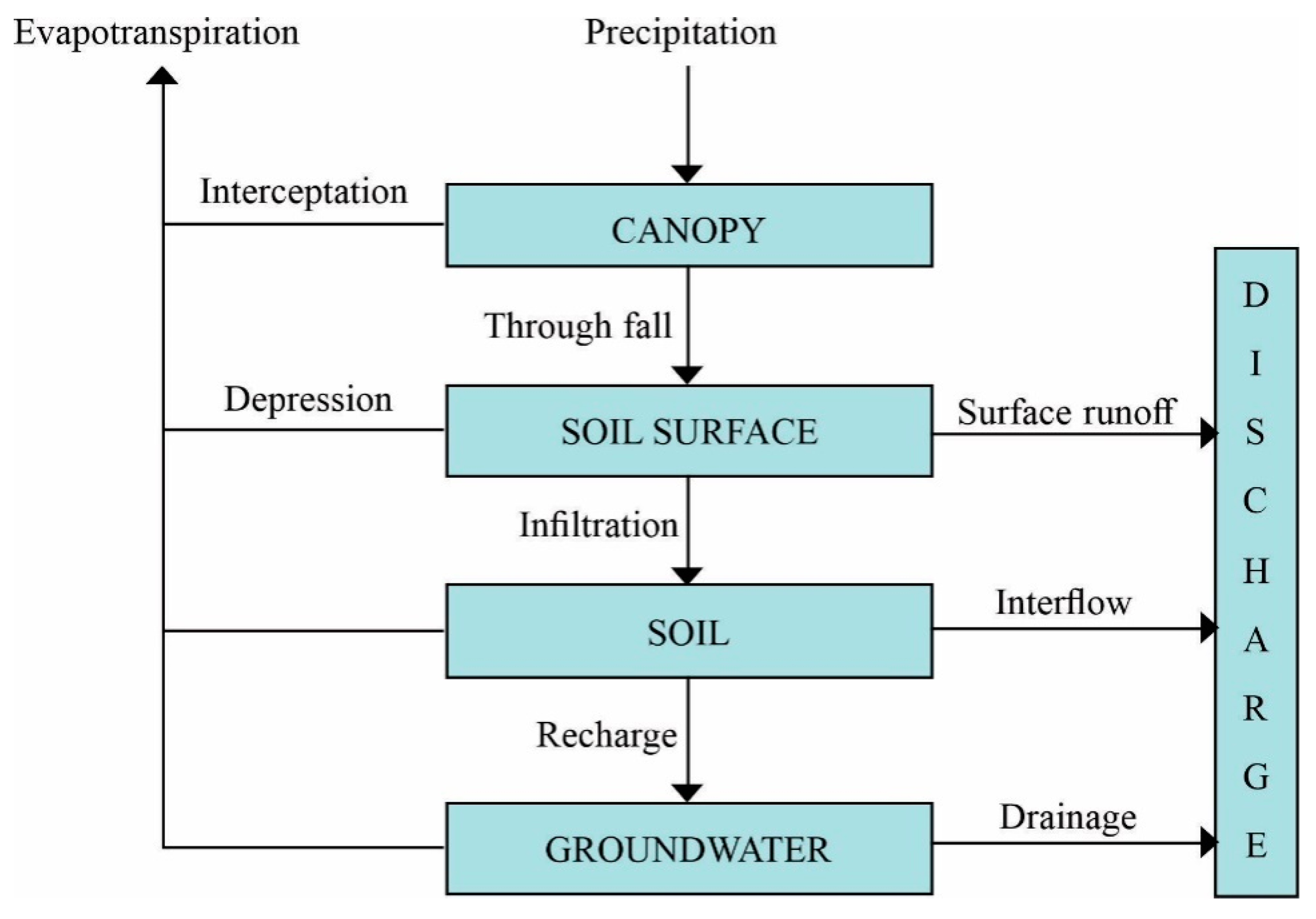
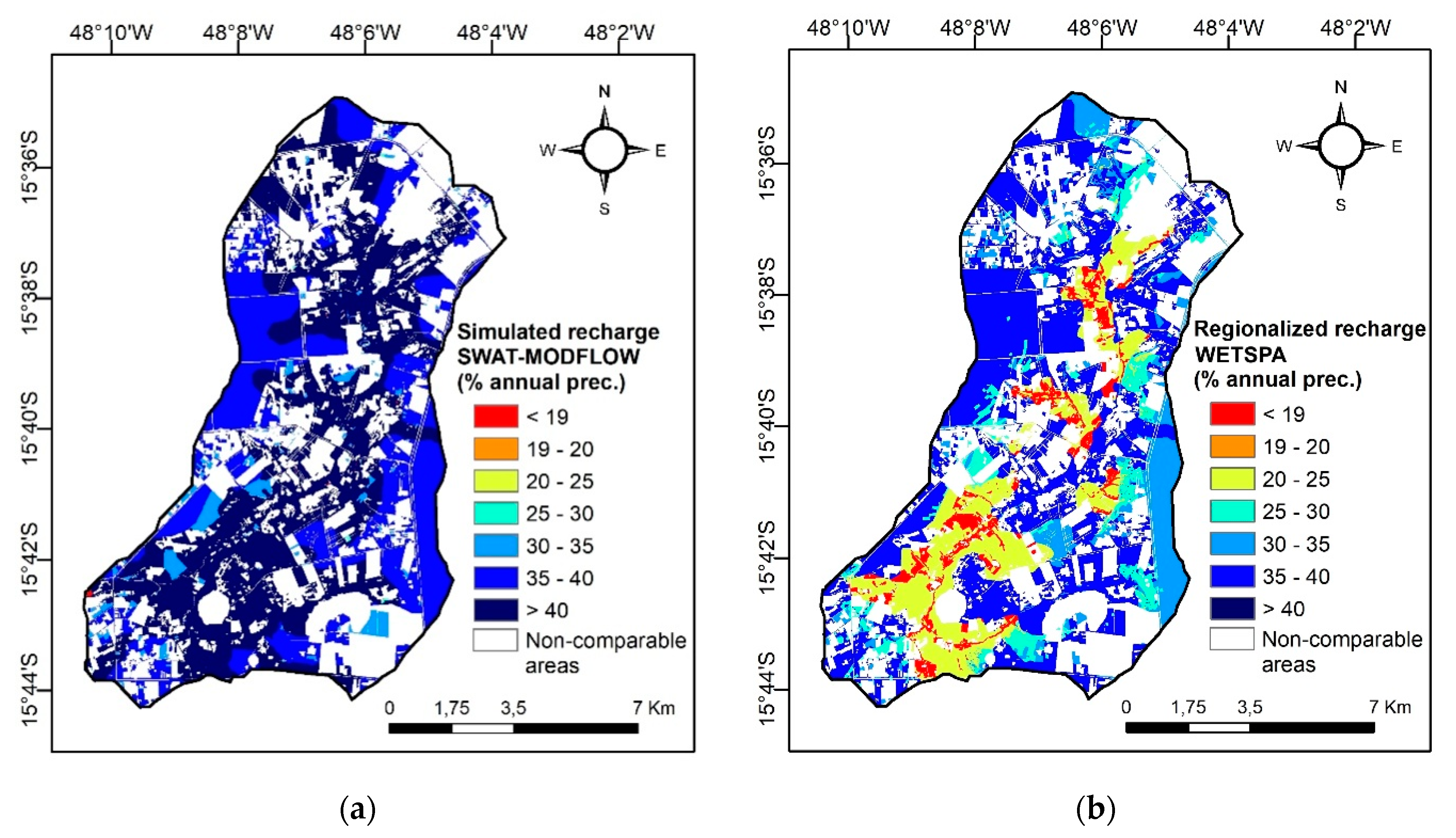
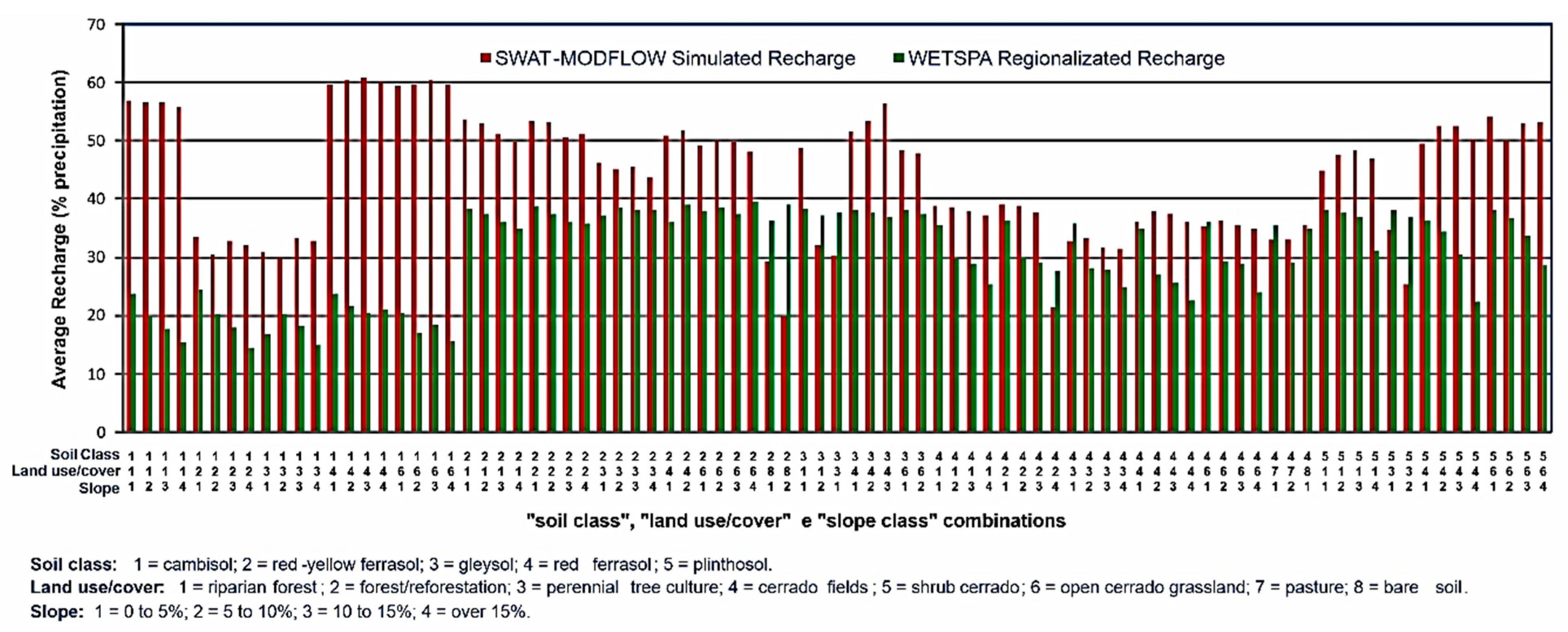
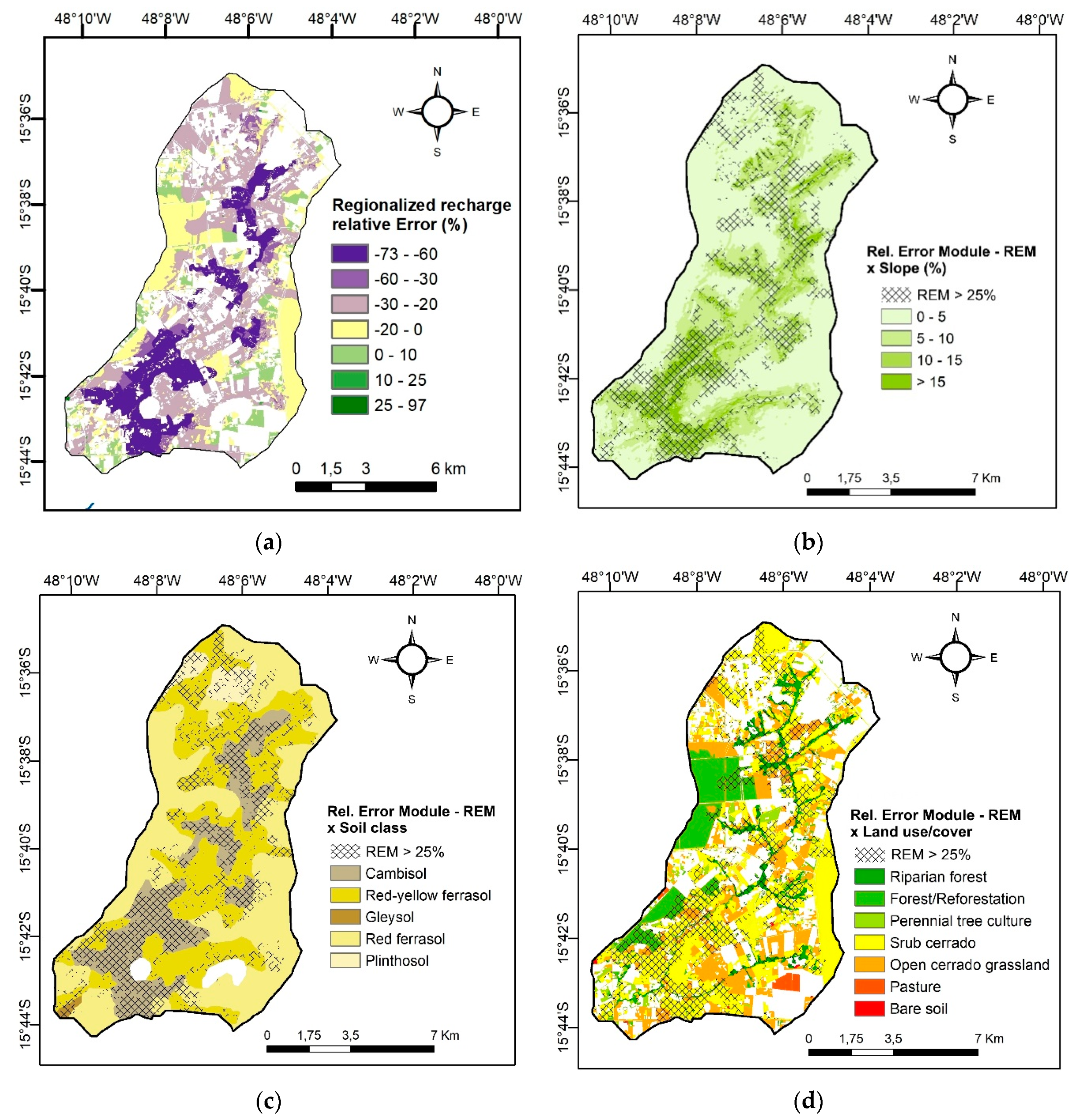
| Code | Simulated Recharge SWAT-MODFLOW (% Annual Prec.) | Regionalized Recharge WETSPA (% Annual Prec.) | Relative Error (%) SWAT-MODFLOW “Versus” WETSPA |
|---|---|---|---|
| 111 | 56.96 | 23.74 | −58.33 |
| 112 | 56.65 | 19.86 | −64.93 |
| 113 | 56.86 | 17.76 | −68.76 |
| 114 | 55.84 | 15.39 | −72.43 |
| 121 | 33.50 | 24.32 | −27.40 |
| 122 | 30.38 | 20.20 | −33.52 |
| 123 | 32.83 | 17.95 | −45.32 |
| 124 | 32.10 | 14.49 | −54.84 |
| 131 | 30.95 | 16.77 | −45.81 |
| 132 | 30.07 | 20.20 | −32.82 |
| 133 | 33.29 | 18.11 | −45.59 |
| 134 | 32.80 | 14.97 | −54.36 |
| 141 | 59.82 | 23.78 | −60.24 |
| 142 | 60.55 | 21.73 | −64.11 |
| 143 | 60.92 | 20.54 | −66.28 |
| 144 | 59.93 | 20.83 | −65.25 |
| 161 | 59.54 | 20.44 | −65.67 |
| 162 | 59.86 | 16.90 | −71.77 |
| 163 | 60.42 | 18.33 | −69.65 |
| 164 | 59.85 | 15.60 | −73.93 |
| 211 | 53.63 | 38.36 | −28.47 |
| 212 | 53.06 | 37.45 | −29.41 |
| 213 | 51.09 | 36.00 | −29.53 |
| 214 | 49.67 | 34.85 | −29.82 |
| 221 | 53.58 | 38.80 | −27.58 |
| 222 | 53.19 | 37.36 | −29.76 |
| 223 | 50.68 | 35.97 | −29.02 |
| 224 | 51.16 | 35.77 | −30.09 |
| 231 | 46.22 | 37.12 | −19.68 |
| 232 | 45.15 | 38.72 | −14.24 |
| 233 | 45.61 | 38.12 | −16.41 |
| 234 | 43.80 | 38.21 | −12.76 |
| 241 | 50.94 | 36.15 | −29.04 |
| 242 | 51.95 | 39.18 | −24.58 |
| 261 | 49.30 | 38.00 | −22.92 |
| 262 | 50.07 | 38.70 | −22.71 |
| 263 | 49.71 | 37.33 | −24.90 |
| 264 | 48.16 | 39.59 | −17.81 |
| 281 | 29.27 | 36.30 | 23.99 |
| 282 | 19.86 | 38.96 | 96.11 |
| 311 | 48.88 | 38.46 | −21.33 |
| 312 | 32.19 | 37.19 | 15.51 |
| 331 | 30.26 | 37.75 | 24.74 |
| 341 | 51.69 | 38.11 | −26.26 |
| 342 | 53.40 | 37.63 | −29.53 |
| 343 | 56.54 | 36.89 | −34.76 |
| 361 | 48.26 | 38.23 | −20.79 |
| 362 | 47.89 | 37.46 | −21.78 |
| 411 | 38.94 | 35.50 | −8.83 |
| 412 | 38.69 | 29.66 | −23.33 |
| 413 | 37.80 | 28.95 | −23.41 |
| 414 | 37.14 | 25.27 | −31.97 |
| 421 | 39.15 | 36.39 | −7.05 |
| 422 | 38.93 | 29.82 | −23.39 |
| 423 | 37.67 | 29.03 | −22.93 |
| 424 | 21.51 | 27.74 | 28.99 |
| 431 | 32.84 | 35.86 | 9.20 |
| 432 | 33.22 | 28.21 | −15.09 |
| 433 | 31.70 | 27.94 | −11.85 |
| 434 | 31.40 | 24.92 | −20.63 |
| 441 | 35.98 | 34.97 | −2.79 |
| 442 | 37.97 | 26.93 | −29.08 |
| 443 | 37.47 | 25.59 | −31.70 |
| 444 | 36.05 | 22.63 | −37.24 |
| 461 | 35.25 | 36.11 | 2.45 |
| 462 | 36.22 | 29.31 | −19.08 |
| 463 | 35.52 | 28.76 | −19.03 |
| 464 | 34.85 | 23.97 | −31.20 |
| 471 | 33.12 | 35.62 | 7.54 |
| 472 | 32.99 | 29.18 | −11.55 |
| 481 | 35.49 | 34.84 | −1.84 |
| 511 | 44.93 | 38.12 | −15.15 |
| 512 | 47.58 | 37.69 | −20.79 |
| 513 | 48.29 | 36.86 | −23.67 |
| 514 | 46.96 | 31.10 | −33.76 |
| 531 | 34.65 | 38.03 | 9.74 |
| 532 | 25.29 | 37.02 | 46.39 |
| 541 | 49.56 | 36.20 | −26.97 |
| 542 | 52.67 | 34.51 | −34.48 |
| 543 | 52.60 | 30.51 | −41.98 |
| 544 | 50.14 | 22.31 | −55.49 |
| 561 | 54.13 | 38.25 | −29.33 |
| 562 | 49.97 | 36.81 | −26.34 |
| 563 | 53.12 | 33.62 | −36.72 |
| 564 | 53.16 | 28.61 | −46.19 |
| Abacus Average Effective Recharge (% prec.) | Method | Average Reference Values (% prec.) | Method |
|---|---|---|---|
| 15 | WTE | 15–25 [59] | WTE |
| 19 | NM | 20 [60] | Baseflow |
| 17 [61] | Baseflow | ||
| 26–30 [62] | WTE | ||
| 16 [63] | Baseflow | ||
| 17 [63] | Baseflow | ||
| 19 [42] | NM | ||
| 16 [7] | WTE | ||
| 24 [8] | Baseflow | ||
| 27 [8] | WTE | ||
| Average = 17 | Average = 20 | ||
Publisher’s Note: MDPI stays neutral with regard to jurisdictional claims in published maps and institutional affiliations. |
© 2020 by the authors. Licensee MDPI, Basel, Switzerland. This article is an open access article distributed under the terms and conditions of the Creative Commons Attribution (CC BY) license (http://creativecommons.org/licenses/by/4.0/).
Share and Cite
Santos, R.M.d.; Koide, S.; Távora, B.E.; Araujo, D.L.d. Abacus to Predict Groundwater Recharge at Non-Instrumented Hydrographic Basins. Water 2020, 12, 3090. https://doi.org/10.3390/w12113090
Santos RMd, Koide S, Távora BE, Araujo DLd. Abacus to Predict Groundwater Recharge at Non-Instrumented Hydrographic Basins. Water. 2020; 12(11):3090. https://doi.org/10.3390/w12113090
Chicago/Turabian StyleSantos, Ronaldo Medeiros dos, Sérgio Koide, Bruno Esteves Távora, and Daiana Lira de Araujo. 2020. "Abacus to Predict Groundwater Recharge at Non-Instrumented Hydrographic Basins" Water 12, no. 11: 3090. https://doi.org/10.3390/w12113090
APA StyleSantos, R. M. d., Koide, S., Távora, B. E., & Araujo, D. L. d. (2020). Abacus to Predict Groundwater Recharge at Non-Instrumented Hydrographic Basins. Water, 12(11), 3090. https://doi.org/10.3390/w12113090





